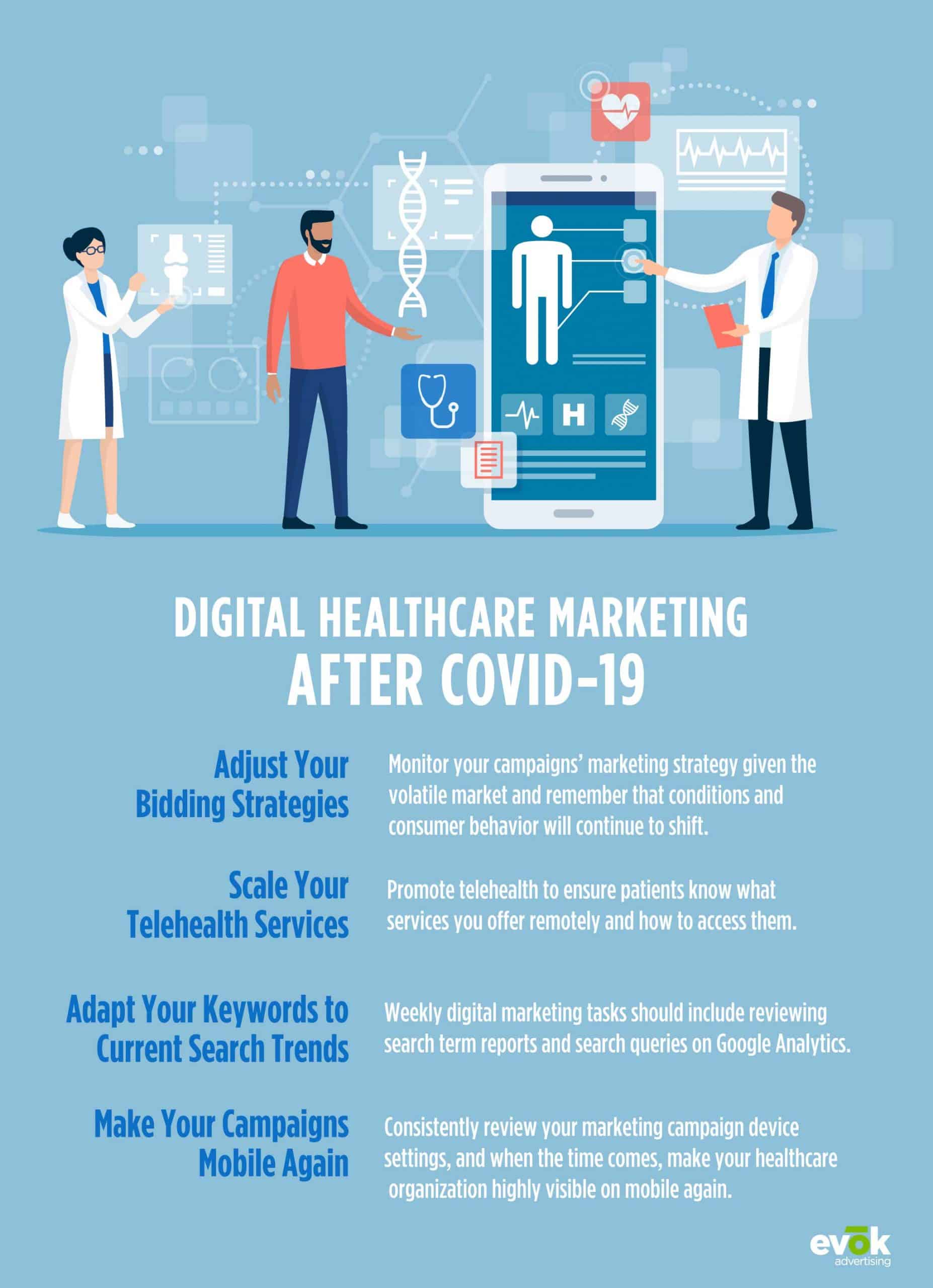
Diagnosing the New Landscape of Digital Healthcare Marketing After COVID-19

As the peak of the COVID-19 crisis moves behind us, more and more people are searching for a new normal, and that includes healthcare marketers trying to identify what the new normal for digital healthcare marketing will be after the pandemic. Over the past few months, the virus has not only affected the health of those in our communities but also the health of marketing campaigns. This year’s events have impacted consumer search behavior and PPC performance. The healthcare industry has paused or reduced their advertising in the last few weeks, and other providers have set responses in place to react to the changes in consumer searches.
To make your digital marketing efforts effective post-COVID-19, your marketing team should begin to plan adjustments in response to the new digital landscape, shifts in searches, competitors, and market share. Your past strategies may no longer apply to your marketing plan after coronavirus, so it’s important to understand what changes have occurred and how to overcome these new challenges.
Adjust Your Bidding Strategies
In light of coronavirus, many healthcare clinics and hospitals redirected their marketing budgets to pay for new equipment and increased staffing during the peak of the COVID-19 outbreak. This means that many PPC, also known as pay-per-click, marketing budgets were put on hold. As the United States and the rest of the world are flattening the curve, healthcare marketers may be looking to restart their PPC campaigns, but sticking to the same automated bidding strategy might not make sense for your marketing after the coronavirus pandemic.
Review and adjust both manual and automated bidding strategies. Make sure to monitor your campaigns’ marketing strategy given the volatile market and remember that conditions and consumer behavior will continue to shift. Establish how often you want to evaluate and potentially update your goals regularly based on performance. The performance could be time-bound (weekly) or it could be geographically bound (regionally). Either way, it’s important to keep your campaign goals up to date and enable automated bidding to do some of the intensive optimizations for you.
Scale Your Telehealth Services
Coronavirus has led to many advancements within the telehealth service industry thanks to better reimbursement, relaxed regulations, and pent-up patient demand. Take advantage of this significant demand for outpatient appointments and promote telehealth to ensure consumers know what services you offer remotely and how to access them. Creating a strategy for telehealth marketing within your current healthcare marketing plan is a sure way to continue your patient acquisition and retention efforts.
Marketing serves as a digital front door to direct patients to the right resources and care delivery options based on their needs. Telehealth is new to most health systems, so just as when you launch any campaign make sure you understand telehealth providers’ capacity to fulfill demand. Otherwise, you may lead new customers to your competitors. And with relaxed cross-state regulations for telehealth, your competition may extend well beyond your service area.
Adapt Your Keywords to Search Trends
Keywords are a powerful resource in marketing. Google Trends is a free digital marketing tool that can help you understand how people are searching for healthcare-related keywords online. This can be a valuable tool in understanding the popularity of searches happening over a given time frame. Google Trends also gives you other interesting data points like interest by region, related topics, and related queries which could all be beneficial when gathering keyword data.
It’s important to adapt your keywords to the current search trends in order to stay on top of healthcare trends. Though many users are currently searching for information using ‘coronavirus’ or ‘COVID-19’ within their queries, many more are searching for more generic keywords. It’s important to recognize the value of these searches as they may be telling more about your customers’ needs during this time. Keywords like ‘pay off medical bills’ or ‘boost immunity’ indicate that a user may be experiencing financial hardship or wants to stay healthy and needs some guidance. How can your healthcare business meet these customers and assist them?
Weekly digital marketing tasks should include reviewing search term reports and search queries on Google Analytics. Gather these intent specific or question-based keywords and develop a content strategy for supporting your customers.
Make Your Campaigns Mobile Again

With stay-at-home mandates slowly being lifted daily routines will go from working from a laptop or desktop at home to going back to mobile use during commutes again. Mobile advertising traffic dropped 13.3 percent during the pandemic, but you will want to adjust your marketing campaigns across all channels for mobile traffic after the quarantine. Consistently review your marketing campaign device settings, and when the time comes, make your healthcare organization highly visible on mobile again.
There will be a number of things to shift back once the coronavirus dust settles, like updating and of your business operations on your website, Google My Business, and Bing Places. It will take time to find the new landscape for marketing after COVID-19, but each of the points above will prepare your marketing strategy efforts for shifts that are expected.